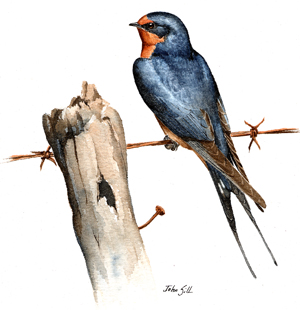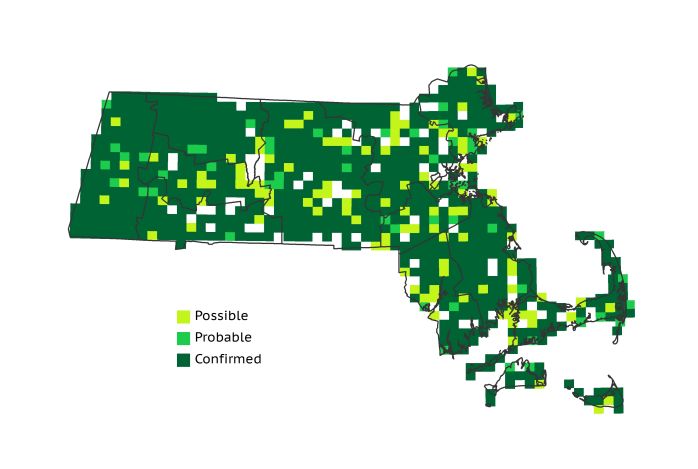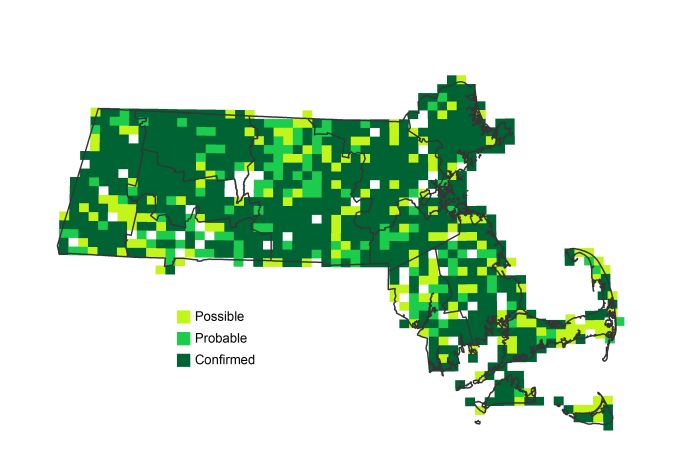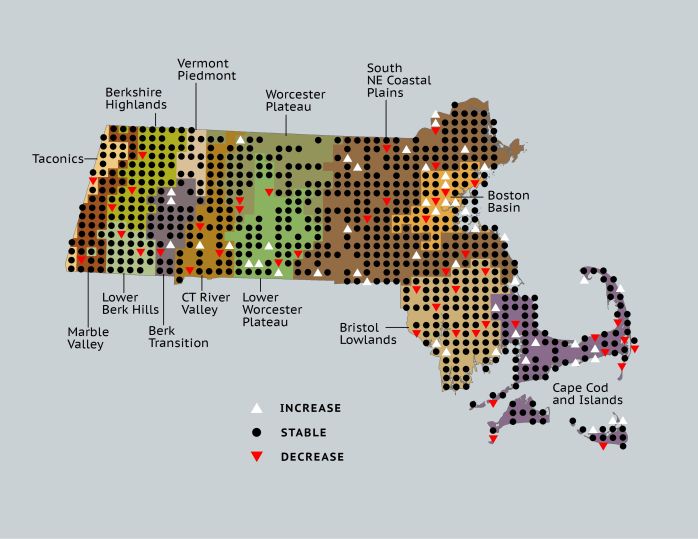Breeding Bird Atlases (BBA)
Find a Bird
Barn Swallow
Hirundo rustica

Nearly ubiquitous and stable
Action/monitoring needed

“Everybody who notices birds at all knows, admires, and loves the graceful, friendly barn swallow. No bird in North America is better known as a welcome companion and useful friend to the farmer, as it comes each spring to fly in and out of the wide-open barn door, delighting him with its cheerful twittering” – Arthur Cleveland Bent, Life Histories of North American Birds
The Barn Swallow is probably the most well-known and well-liked member of its clan. Barn Swallows are handsome birds, with pleasing color patterns of buff, red, and metallic blue; elegantly forked tails; and a penchant for low-altitude aerobatics. Ball fields and farm fields are among their preferred feeding areas, where they are able to actively skim the surface of the grass in search of flying insects. True to their name, they often construct their mud-and-grass nests in barns, though they can show up almost anywhere. Since they are not cavity nesters, they are afforded some protection from House Sparrow competition; however, their status in the state is still uncertain.
Historic Status
Prior to the arrival of European settlers to Massachusetts, Barn Swallows nested in caves, under ledges, and in other similar places that provided a roof over their heads (Forbush 1929). Once human-made structures began dotting the landscape, the birds quickly took advantage of them as nesting sites (Forbush 1929). One might surmise that the end of the farming era in Massachusetts should have led to a decline in the species’ abundance in Massachusetts. In 1900, two chroniclers went so far as to say that Barn Swallows were “gradually losing ground in the eastern portions of the state as the old-fashioned barns become replaced by modern structures” (Howe & Allen 1901). This was clearly not entirely the case, however. The species ultimately adapted to twentieth-century Massachusetts and continued to thrive.
Atlas 1 Distribution
The results from Atlas 1 showed that Barn Swallows were nearly ubiquitous in the western part of the state. Barring a few blocks in the Berkshire Transition and a handful in the southern Connecticut River Valley, Barn Swallows were found in every block in western Massachusetts, and were more often Confirmed than not. While the species was generally well distributed, there were some notable breaks in Barn Swallow distribution across the Lower Worcester Plateau region. The Coastal Plains, where historic barns and farm sites were perhaps most threatened by development, showed the first signs of decline for the species. Distribution was also patchy in the eastern Boston Basin, where development was most intense. Still, Barn Swallows were found all throughout the Bristol/Narragansett Lowlands and in just over 75% of Cape Cod and the Islands.
Atlas 2 Distribution and Change
Although technically listed as stable in this report, Barn Swallows showed a slight increase in block occupancy between the Atlases, from 862 blocks in Atlas 1 to 921 in Atlas 2. The latter number is likely close to the saturation point for Massachusetts, making the Barn Swallow one of the state's most prevalent species in modern times. Yet, despite the obvious presence of the species across the state, many observers had a difficult time gathering Confirming evidence of breeding activity during Atlas 2. Perhaps those notable breaks in Atlas 1, some of which increased during Atlas 2, mirrored the loss of old barns across Massachusetts, and represent a harbinger of things to come for the Barn Swallow. No region had a net loss of Barn Swallows greater than the Bristol/Narragansett Lowlands’ 5 blocks, but such abandoned blocks were widely distributed and imply habitat changes at the local level.
Atlas 1 Map

Atlas 2 Map

Atlas Change Map

Ecoregion Data
Atlas 1 | Atlas 2 | Change | ||||||
Ecoregion | # Blocks | % Blocks | % of Range | # Blocks | % Blocks | % of Range | Change in # Blocks | Change in % Blocks |
Taconic Mountains | 16 | 100.0 | 1.9 | 18 | 72.0 | 2.0 | -1 | -6.7 |
Marble Valleys/Housatonic Valley | 39 | 100.0 | 4.5 | 38 | 97.4 | 4.1 | -1 | -2.6 |
Berkshire Highlands | 55 | 100.0 | 6.4 | 52 | 94.5 | 5.6 | -3 | -5.7 |
Lower Berkshire Hills | 28 | 100.0 | 3.2 | 26 | 83.9 | 2.8 | -2 | -7.4 |
Vermont Piedmont | 17 | 100.0 | 2.0 | 17 | 100.0 | 1.8 | 0 | 0.0 |
Berkshire Transition | 35 | 92.1 | 4.1 | 37 | 92.5 | 4.0 | 2 | 6.5 |
Connecticut River Valley | 51 | 91.1 | 5.9 | 55 | 84.6 | 6.0 | -1 | -2.1 |
Worcester Plateau | 72 | 92.3 | 8.4 | 77 | 87.5 | 8.4 | -1 | -2.1 |
Lower Worcester Plateau | 64 | 86.5 | 7.4 | 72 | 90.0 | 7.8 | 1 | 1.9 |
S. New England Coastal Plains and Hills | 235 | 87.0 | 27.3 | 266 | 94.0 | 28.9 | 9 | 4.0 |
Boston Basin | 46 | 82.1 | 5.3 | 51 | 91.1 | 5.5 | 4 | 7.3 |
Bristol and Narragansett Lowlands | 98 | 92.5 | 11.4 | 95 | 83.3 | 10.3 | -5 | -5.0 |
Cape Cod and Islands | 106 | 77.9 | 12.3 | 117 | 81.3 | 12.7 | 3 | 2.5 |
Statewide Total | 862 | 89.0 | 100.0 | 921 | 88.8 | 100.0 | 5 | 0.6 |
Notes
The Barn Swallow shows significant decreasing Breeding Bird Survey (BBS) trends in Massachusetts, the New England/mid-Atlantic Coast region, and the Eastern US overall. They fall into our “whispering bird” category – those species with a demonstrated stable or increasing breeding footprint from Atlas 2 data, but also a demonstrated decline in abundance from the BBS. This drives our final assessment that this is a species with a need for further monitoring and conservation action.



